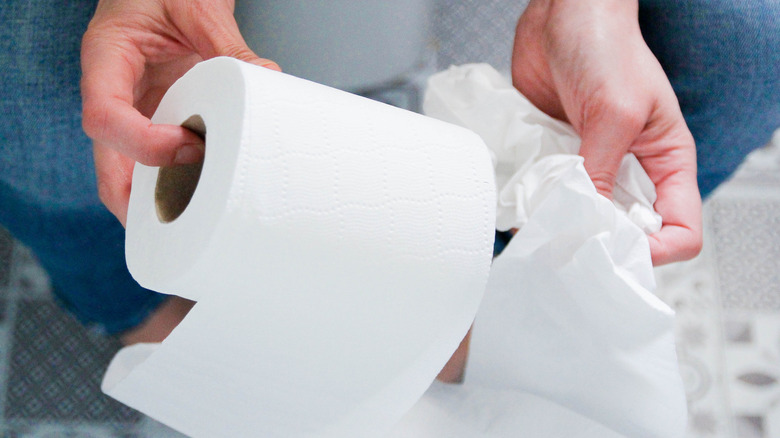The Little-Known Cancer That Can Change The Color Of Your Poop And Pee
Sometimes your trip to the bathroom can leave peculiar colors based on what you eat and drink. Eating a lot of beets might strike fear as you notice some bright red in your toilet. Some medications could make urine strange colors like orange or green. Your poop could be green if you took an iron supplement, and some diarrhea medicines can turn your poop a pale color.
Although temporary changes to the color of your poop and pee can be harmless, some changes could signal a more serious condition. In a Health Digest interview, Sharona Ross, M.D., FACS, a board-certified advanced Foregut and Hepato-Pancreato-Biliary (HPB) surgeon with the Digestive Health Institute at AdventHealth Tampa, says that dark yellow urine and yellow poop could be an early sign of bile cancer.
"The darkening of urine happens because high levels of bilirubin, a component of bile, are filtered into the urine, making it darker in color," she explained. "On the other hand, stools become pale, greasy, or clay-colored due to the absence of bile in the digestive system." According to Ross, there are other warning signs of bile duct cancer worth noting.
Symptoms of bile duct cancer
Your liver makes bile to digest fat and rid your body of waste. Bile is greenish-yellow and stored in your gallbladder (bile is also called gall). When your digestive system needs more bile, it flows through bile ducts. These bile ducts also move bile from the liver to the gallbladder. Bile duct tumors can form along this network of bile ducts.
"When bile duct cancer causes an obstruction in the bile duct, bile produced by the liver cannot flow into the small intestine to aid in fat digestion," Ross said. "This backup of bile leads to jaundice, which causes a yellowing of the skin and eyes." Jaundice is a noticeable early sign of bile duct cancer, along with itchy skin, darker urine, and pale poop.
Another sign of bile duct cancer is abdominal pain just under your right ribs, which is where your gallbladder and bile ducts are. "Other symptoms can include a loss of appetite, unintended weight loss, and fever, which may indicate cholangitis — a swelling of the bile duct results from infection," explained Ross. She recommends seeing your doctor if you're experiencing any of these symptoms.
How common is bile duct cancer?
Although bile duct cancer is more common in Southeast Asia, it's relatively rare in the United States, with about 8,000 diagnoses each year (via the American Cancer Society). To put that into context, more than 313,000 people each year are diagnosed with breast cancer, and 299,000 receive a prostate cancer diagnosis. Bile duct cancer occurs mostly in older adults, with the average age of diagnosis at 70.
Bile duct cancer can spread quickly, which makes it more difficult to treat. People who have bile duct cancer that starts within the liver have a 5-year survival rate of 23% if the cancer hasn't spread outside the bile duct. If the tumor begins in bile ducts outside the liver, the 5-year survival rate is 18%.
A change in the color of your pee, poop, and skin doesn't necessarily mean you have bile duct cancer, but these symptoms still warrant seeking medical attention (here's what color your pee should be). Having dark urine can be a sign of dehydration, and yellow diarrhea could signal giardiasis. Jaundice is also a symptom of conditions such as hepatitis, sickle cell anemia, or nonalcoholic fatty liver disease.


